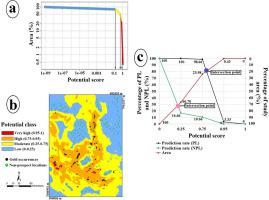Journal of Geochemical Exploration ( IF 3.9 ) Pub Date : 2021-07-21 , DOI: 10.1016/j.gexplo.2021.106858 Bijan Roshanravan 1 , Oliver P. Kreuzer 2, 3 , Sadjad Mohammadi 4 , Matt Bruce 5 , James Davis 6 , Matt Briggs 6

|
This study describes the supervised support vector regression method and cuckoo optimization algorithm (COA-SVR), a newly developed mineral potential modelling (MPM) technique, and a case study of its application to predicting gold potential in the Granites-Tanami Orogen (GTO), Australia. COA-SVR, which was borne out of a computer program coded in MATLAB®, incorporates a popular radial basis function (RBF) known as the Gaussian kernel function. The COA-SVR model was trained using a series of predictor maps previously generated and described by Roshanravan et al. (2020a), and corroborated by way of a 10-fold cross-validation. The modelling results indicate that the COA-SVR approach to MPM outperformed the previous data-driven (i.e., random forest) and continuous (i.e., fuzzy gamma, geometric average, and data-driven index overlay) models of Roshanravan et al. (2020a). As such, the newly proposed COA-SVR method presents a valid approach to MPM. To further constrain the results, the gold prospective domains identified via COA-SVR and the previous models of Roshanravan et al. (2020a) were delimited, using the student's t-value and concentration-area (C-A) fractal techniques. Following the above, indices of overall performance (Oe), accuracy (A), kappa (K) and normalized density (Nd) were applied to further assess the gold prospective domains as delimited by the student's t-value and C-A fractal techniques. The results are consistent with the COA-SVR and random forest models having outperformed the more traditional modelling approaches documented by Roshanravan et al. (2020a). Given the positive results obtained in this study and similarly positive results reported by others, we believe that the apparent superior nature of machine-learning algorithms strongly merits further consideration, research and more widespread application in MPM.
中文翻译:

用于支持向量回归潜力分析的 Cuckoo 优化算法:来自澳大利亚 Granites-Tanami Orogen 的示例
本研究描述了监督支持向量回归方法和布谷鸟优化算法 (COA-SVR)、一种新开发的矿物潜力建模 (MPM) 技术,以及其在花岗岩-塔纳米造山带 (GTO) 中预测金潜力的应用案例研究, 澳大利亚。COA-SVR 由在 MATLAB® 中编码的计算机程序生成,并结合了流行的径向基函数 (RBF),称为高斯核函数。COA-SVR 模型是使用 Roshanravan 等人先前生成和描述的一系列预测器图进行训练的。(2020a),并通过 10 倍交叉验证得到证实。建模结果表明,用于 MPM 的 COA-SVR 方法优于以前的数据驱动(即随机森林)和连续(即模糊伽马、几何平均、和数据驱动的索引覆盖)Roshanravan 等人的模型。(2020a)。因此,新提出的 COA-SVR 方法提供了一种有效的 MPM 方法。为了进一步限制结果,通过 COA-SVR 和 Roshanravan 等人的先前模型确定的黄金预期域。(2020a) 使用学生的 t 值和集中区 (CA) 分形技术进行划界。综上所述,综合业绩指标(O e )、准确度 ( A )、kappa ( K ) 和归一化密度 ( N d ) 用于进一步评估由学生的 t 值和 CA 分形技术界定的黄金预期域。结果与 COA-SVR 和随机森林模型一致,其性能优于 Roshanravan 等人记录的更传统的建模方法。(2020a)。鉴于本研究中获得的积极结果以及其他人报告的类似积极结果,我们认为机器学习算法明显优越的性质非常值得在 MPM 中进一步考虑、研究和更广泛的应用。


























 京公网安备 11010802027423号
京公网安备 11010802027423号